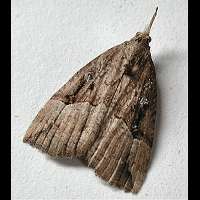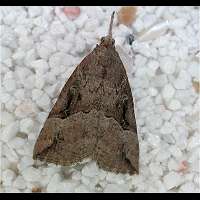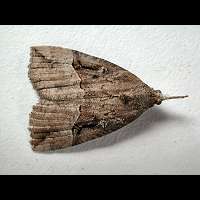Buttoned Snout Hypena rostralis
The snouts are not among the easiest of Moths to tell apart. Luckily though the Buttoned Snout is an unmistakable species. It has very slender wings, which it keeps tight together on top, when resting. This makes it look much slimmer than other snouts. Which is a good thing, by the way, for this is a highly variable species. Some animals are neatly marked, but others are almost without markings and uniformly coloured. The wingspan is between 27 and 32mm.
The eggs are being deposited in spring in small groups on the leaves of the foodplant. They hatch after some three to five weeks, meaning most larvae are active in June and July. They feed by night and hide on the underside of a leaf during the day. The damage they do to the leaves of the foodplant is characteristic: very large holes in the middle of a leaf. From August pupation starts. A strong cocoon is attached to the underside of a leaf and inside the miracle happens: an plump caterpillar changes into a gracious moth. Pupation usually takes anything from two to six weeks. So the adults commence appearing from mid-August. They are on the wing to June next year, meaning the adults are the ones overwintering. The caterpillar is like many others: light green with a thin white dorsal line and small black spots. A bigger white line runs over both sides and the head is yellowish green. The larva reaches a length of some 22 to 25mm and is found on hop exclusively.
The Buttoned Snout is flying about from mid-August to October and from March to June. From November to February it will be overwintering in a sheltered place. This may be a hollow tree, cave, bunker, shed, house or garage. So the Buttoned Snout is found indoors regularly. It only flies by night, but is seen in dusk in autumn visiting ivy blossom. Can be caught to be photographed easily and may even be handled. Uncommon on places covered with hop in Southern and Central England. rare in Southern Wales, not found in Scotland and Ireland. On the continent a rather uncommon and often very local species too.
The snouts are not among the easiest of Moths to tell apart. Luckily though the Buttoned Snout is an unmistakable species. It has very slender wings, which it keeps tight together on top, when resting. This makes it look much slimmer than other snouts. Which is a good thing, by the way, for this is a highly variable species. Some animals are neatly marked, but others are almost without markings and uniformly coloured. The wingspan is between 27 and 32mm.
The eggs are being deposited in spring in small groups on the leaves of the foodplant. They hatch after some three to five weeks, meaning most larvae are active in June and July. They feed by night and hide on the underside of a leaf during the day. The damage they do to the leaves of the foodplant is characteristic: very large holes in the middle of a leaf. From August pupation starts. A strong cocoon is attached to the underside of a leaf and inside the miracle happens: an plump caterpillar changes into a gracious moth. Pupation usually takes anything from two to six weeks. So the adults commence appearing from mid-August. They are on the wing to June next year, meaning the adults are the ones overwintering. The caterpillar is like many others: light green with a thin white dorsal line and small black spots. A bigger white line runs over both sides and the head is yellowish green. The larva reaches a length of some 22 to 25mm and is found on hop exclusively.
The Buttoned Snout is flying about from mid-August to October and from March to June. From November to February it will be overwintering in a sheltered place. This may be a hollow tree, cave, bunker, shed, house or garage. So the Buttoned Snout is found indoors regularly. It only flies by night, but is seen in dusk in autumn visiting ivy blossom. Can be caught to be photographed easily and may even be handled. Uncommon on places covered with hop in Southern and Central England. rare in Southern Wales, not found in Scotland and Ireland. On the continent a rather uncommon and often very local species too.







